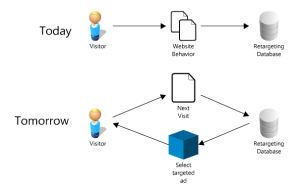 The Retargeting plugin for Revive Adserver adds a table to the existing Revive Adserver database, and stores information about the visitor in that table. Alternatively, the data can also be stored in a cookie on the visitor’s computer, for extreme scalability. It then enables Revive Adserver users to specify delivery limitations to any banner in a campaign based on the stored retargeting data.
The Retargeting plugin for Revive Adserver adds a table to the existing Revive Adserver database, and stores information about the visitor in that table. Alternatively, the data can also be stored in a cookie on the visitor’s computer, for extreme scalability. It then enables Revive Adserver users to specify delivery limitations to any banner in a campaign based on the stored retargeting data.

Retargeting plugin stores data and re-uses that data later to determine which ad should be displayed
Storing retargeting data
Revive Adserver assigns a unique random identifier to each web visitor at the first encounter. This identifier is used to store other information set through our plugin’s API. The retargeting data can be stored in the Revive Adserver database, in an external database or even in a cookie on the visitor’s computer.
Limiting ad delivery through retargeting
An Revive Adserver user can define one or multiple delivery limitations on any banner. This instructs the ad selection process to deliver that banner only when any and all of the conditions as specified have been satisfied. In the case of retargeting, this means a banner can be targeted today on the basis of data that was collected yesterday, or last week, last month or any time in the past for that matter.
Scalability
Data will, by default, be stored in a table in the Revive Adserver database, but we also provide a free ‘External Database Driver” to enable system administrators to move the retargeting data table to an external database, which can even be on a separate server.
The data will normally not be stored in cookies on the visitor’s computer, but in a database. However, for large systems with many visitors, we’ve developed a “high volume extension” which adds the ability to store data in cookies on the visitor’s computer, rather than in the database. The high volume extension is not free.
Examples of retargeting
The only limitation for using the TargetiX – Retargeting Plugin for Revive Adserver is your own imagination. Here are a few examples of how we think you can use this plugin:
- When a visitor enters your shop pages but doesn’t complete a sale, you could display special ads at their next visit, encouraging them to buy your product after all.
- When a visitor searches for information related to a US state, you can target ads to them that are relevant to that state, when they visit one of your other sites in the future.
- If a visitor has viewed a product page on your website more than 5 times, you may want to assume that they are more than likely to buy the product. By displaying an ad with a special offer or discount at their next visit, you could persuade them to buy the product.
- When someone buys a product from your site, at subsequent visits to your site you can show them ads for related products, supplies or services to complement their initial purchase (up selling and cross selling).
There is more on our page of examples and use cases for the Retargeting plugin for Revive Adserver.
Additional technical details
Data storage mechanism
The data that needs to be captured comes from the actions a visitor performs on a website, or from data the visitor enters. This data is sent to Retargeting plugin for Revive Adserver via an API. It requires that the webmaster or developers of the website incorporate this API in their site. There are no restrictions on the programming language used for the site. The plugin supports two types of data storage: single elements like a visitor’s gender or year of birth, and counters like the number of times a visitor has viewed a product page in your shop.
Privacy Measures and Opt-Out Mechanism
Any data stored inside the retargeting data table is completely anonymous. It is not tied to an IP address. The Retargeting plugin for Revive Adserver even supports an opt-out mechanism. This means that visitors can indicate that they prefer not to be served ads targeted to their search or surfing behavior. Any and all data about the visitor in the Revive Adserver database or in the cookies on their own computer is removed and no more new data will be collected.
Would you like to learn more?
Please use this form to contact us, we will be in touch with you shortly to provide any other information you request.
